You haven't experienced birding until you see a hawk soaring in the sky. It's such a beautiful sight! Even small ones, like the sharp-shinned hawk with its wing-to-wing length of 22 inches, look majestic when they flap and glide.
Actually…
That's what awaits you when birding to see the hawks in Tennessee. We want to give you a comprehensive list, including advice on field markings that differentiate these birds. Are you ready? Read on!
7 Hawks In Tennessee & Where To See Them
If you're wondering if there's any resemblance between owls and hawks, these birds of prey aren't as spooky-faced as owls. They have stunning plumage with dark barring and banded tails.
Some are as small as songbirds, so you might miss them when there are dozens of larger birds around them. Here are the species in Tennessee.
1. Northern Harrier: Scientific Classification - Circus hudsonius
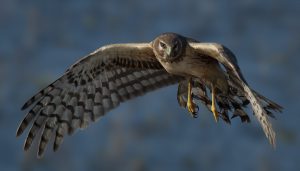
Males and female harriers have different color patterns. Female northern harriers have brown plumage above, while males flaunt a gray back, white underside, and a white rump. We'll forgive you for thinking it's a raptor because its long, broad wings and tail are nothing like hawks on this list.
Although many think they're owls, northern harriers aren't as large as red-shouldered or rough-legged hawks because their average size is 18.1 to 19.7 inches.
A northern harrier eats small birds like song sparrows, northern cardinals, and meadowlarks. It also hunts small mammals, such as voles, when birds aren't available.
Northern harriers are in Tennessee in winter as they spend the breeding season North and winter south. A few middle states have a resident population; unfortunately, TN is not one of them.
2. Red-tailed Hawk: Scientific Classification - Buteo jamaicensis
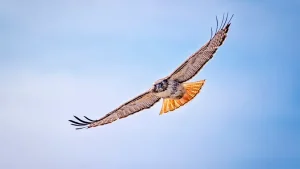
You'll not forget what a red-tailed hawk looks like because its characteristic red tail is unmatched. When you see it soaring, you notice a red tail and a dark band across the belly contrasting a pale underside.
It also has a white throat, brown head, and dark tips on flight feathers. Nevertheless, there are regional differences, with dark morphs more common in western states.
Red-tailed hawks are large avians as females can grow to 25.6 inches. Males average 17.7 to 22 .1 inches long, about the size of rough-legged hawks.
They live throughout the state, so it's no wonder you see red-tailed hawks perched on fence posts in the countryside.
Like other hawk species, the red-tailed hawk eats small birds like pheasants and blackbirds. If such food isn't available, it settles for rabbits, voles, ground squirrels, and other small animals.
3. Northern Goshawk: Scientific Classification - Accipiter gentilis
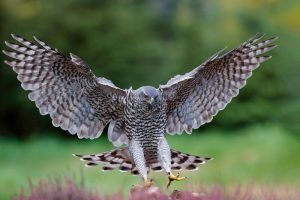
Northern goshawks winter in Tennessee and adjacent states, even though they are rare sightings in suburbs because they inhabit expansive forests.
Northern goshawks are related to sharp-shinned and Cooper's hawks, both of which are in this state. However, northern goshawks have longer bodies, between 20.9 and 25.2 inches long.
A northern goshawk has a gray body with pale gray underparts with bars. You also notice white eyebrows contrasting a dark head and yellow eyes.
4. Sharp-shinned Hawk: Scientific Classification - Accipiter striatus
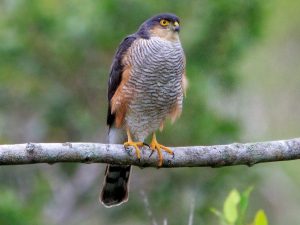
It's migratory and winters in Tennessee, although there's a resident population of sharp-shinned hawks in the eastern area of the state.
You would expect hawks to be large species, but sharp-shinned hawks are the opposite because they fall in the same body length category as blue jays. They're medium-sized, between 9.4 and 13.4 inches from bill-to-tail, which means they're smaller than American crows.
A sharp-shinned hawk loves bird feeders because that's one of the best places to hunt songbirds effortlessly.
It stays in a dense forest when it's not waiting for songbirds in human settlements and nests in coniferous trees. To identify this medium-sized bird, look for an avian with a blue-gray back, a strongly banded tail, and a red-orange chest.
If you haven't seen a sharp-shinned hawk before, it's similar to Cooper's hawk. However, Cooper's is about six inches longer than a sharp-shinned.
You may never see the two species perched close to each other, so the other way to differentiate them is by their sound as a sharp-shinned hawk makes a kik sound, whereas Cooper's produces cak sounds.
5. Cooper's Hawk: Scientific Classification - Accipiter cooperii

Cooper's hawks have the same red-orange underside and blue-gray backs as the sharp-shinned. These birds of prey have varying sizes between the sexes, so the males are between 14 and 15 inches long, while females can grow up to 17.7 inches.
This species has a resident population in North America, including Tennessee, except the southern edge of Texas and other states that host wintering birds.
You'll often see Cooper's hawk flying through the canopy chasing red-winged blackbirds or starlings in woodlands or field edges. Hence, many homeowners discourage it from visiting their backyard feeders because it chases away songbirds.
If Cooper's hawk shows up, be mean to all birds and take down your feeders until this predator gets bored and flies away.
6. Red-shouldered Hawk: Scientific Classification - Buteo lineatus
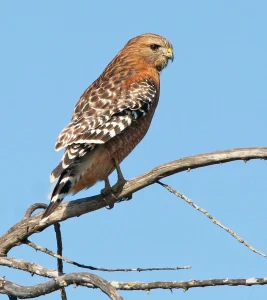
The red-shouldered hawk species inhabits this state all year round, preferring to live in wet forests where it can hunt frogs and snakes.
To identify a red-shouldered hawk, look for an avian with dark bands on its tail, checkered wings, and rufous bars on the belly.
Red-shouldered hawks reuse nests and lay up to five white or blue eggs. You find such nests on trees with broad leaves growing near water. American crows attack these hawks, although they both attack and steal food from each other.
These large hawks are between 16.9 and 24 inches long, with a wingspan of up to 43.7 inches.
7. Broad-winged Hawk: Scientific Classification - Buteo platypterus
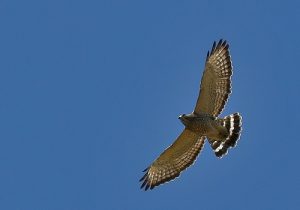
You will see broad-winged hawks in TN; however, they live in woodlands and rarely come to human settlements.
The ones in Tennessee visit during the breeding season as this range is in the eastern states. After summering in North America, broad-winged hawks fly south to winter in Central America and the northern counties of South America.
It's not a short trip, as a broad-winged hawk can cover up to 4,000 miles to reach the wintering grounds. This migration is phenomenal, with thousands of birds flying south together, forming what birders call a kettle.
If you miss the migration, another worthwhile moment is when you see a broad-winged hawk hunting. It perches on a tree, scans the surroundings, and waits for the right time to pounce on unsuspecting frogs, toads, and small mammals.
A broad-winged hawk is about the size of Cooper's falcon as its body length ranges from 13.5 to 17.5 inches; however, it's smaller than a red-shouldered hawk. Like some owls mentioned above, it has broad wings with pointed tips, a barred underside, and a banded tail.
Like rough-legged hawks, there are light and dark morph birds, with the latter displaying dark brown bodies. Nevertheless, dark morph birds are rare. The broad-winged hawk belongs to the genus Buteo, which comprises other hawks like red-tailed hawks, Swainson's hawks, and rough-legged hawks.
Bird Point: You might want to visit Montana for a change of scenery and, of course, bird watching habits. Read our post about popular birds worth seeing in this state here -- Birds Of Montana: 17 Special Species Of The Big Sky Country.
Where To See Hawks In TN
Now you know this state has seven hawk species. It's time to list a few places you can spot these birds:
Frozen Head State Park
A seven-mile hike to the park's observation tower is the perfect experience in spring and summer. You can imagine the scenery to expect in this park situated within Cumberland Mountains. As you explore it, remember that somewhere in the 24,000 acres of the park is the home of the broad-winged hawks.
Sharp's Ridge Memorial Park
If you're in east Tennessee, this park in Knoxville hosts several hawks in fall and spring. This limestone ridge has a pine forest with a diverse understory to host different avians.
Brainerd Levee
Red-tailed, red-shouldered, and Cooper's are common hawks in this birding zone in Chattanooga throughout the year. It's an enchanting habitat comprising wetlands, woodlands, marshes, and shrubs.
Reelfoot National Wildlife Refuge
It's in Obion County and has an expansive conservation area comprising forests and croplands. The red-shouldered hawk is one of the many species that nest in this wildlife sanctuary.
Watch This!
Frequently Asked Questions
How big are the hawks in TN?
The largest is the northern goshawk, though the red-shouldered and red-tailed avians aren't too far behind on the list. On the other hand, the sharp-shinned are the smallest hawks in TN. Check the body lengths we discussed earlier.
How many types of hawks are in TN?
There are seven species, including the broad-winged hawk, the northern harrier, and the red-tailed hawk. The rough-legged hawk isn't in this state because its wintering range is in most of the United States except the southeastern states like Tennessee, Alabama, and Georgia.
Are Cooper's hawks in TN?
Yes, you'll come across them when touring woodlands and forests. They even come to backyard feeders.
Are there hawks in East Tennessee?
Yes, you'll see sharp-shinned hawks in that region throughout the year. Others prevalent all months of the year are red-shouldered hawks.
Are there falcons in Middle Tennessee?
Yes, the ones with a resident population in Tennessee also inhabit the middle region, and they include the red-shouldered and Cooper's hawk.
Conclusion
Yes, Tennessee has hawks. There are seven species ranging from large to medium-sized birds about the size of a jay. Two that are difficult to tell apart are the sharp-shinned and Cooper's. Their cousin, the northern goshawk, is also in TN but has a different color pattern.
Lastly, you may find them hunting in your backyard since hawks eat small mammals and songbirds. Thus, the next time you see titmice and doves take off suddenly, there's a hawk in the branches.

